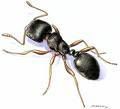Sunday, January 20, 2008
Identifying an Infestation of Termites and Ants
This publication is one of the best that I've found to summarize how to identify if your home has termite or carpenter ant infestation. Some of the signs of Subterranean termites include mud tunnels, piles of wings and damaged wood that may sound like a hollow thud when tapped with a hammer. It's interesting to note how wood damaged by ants can look different than wood damaged by termites. Ants leave the tunnels in the wood clean where as the termites leave the tunnels messy looking.
The publication also provides a good summary of treatment options with the trade-offs for bait and barrier systems.
Monday, August 27, 2007
Pesticide Alternatives for Controlling Termites
Not all experts agree that Orange Oil is effective against dry-wood termites. This UC Davis resource claims that there has been no published studies verifying the efficacy of Orange Oil in controlling drywood termites. There may be questions about its usefulness against drywood termites, but I don't see anyone saying it's effective against other termites like the subterranean termites. So first be sure that the termites you have are in fact the drywood variety. My post on termite identification may help you determine the type of termites you have. Drywood termites are most often found in California, Arizona, Florida, Alabama, Georgia, Louisiana, Mississippi, South Carolina, Texas and Virginia (credit to NPMA).
Labels: drywood termites, pesticide alternatives
Thursday, August 17, 2006
Avoiding Termite Pest Control Scams
- Inspector charged hundreds of dollars for surface spraying around the house which was useless for the termites being targeted
- Inspector who claimed the house needed a $500 treatment for subterranean termites without an interior inspection
- Subcontractor pest control that used bogus chemicals for the subterranean termite treatment before the building of a new house.
There are a few basic things to help avoid being ripped off. In addition to receiving several estimates, make sure the termite company is a member of the BBB and the National Pest Management Association. If you are having a house built, make sure to choose your own termite subcontractor.
Tuesday, February 14, 2006
Eastern Subterranean Termites Active Even in February in South Dakota
The termite type that is present in South Dakota and is the most common in the US is the Eastern subterranean termite. These termites are present in most southern states from New Mexico to Florida and include most of the northern states from South Dakota and Minnesota to New Hampshire.
Do I Have Termites?
Some signs that the Eastern subterranean termites may be present in your home include mud tubes around the foundation. Also, you might start noticing winged insects flying around. This is especially the case during this time of the year and into the spring. These could be termite swarmers also known as winged reproductives.
Here's a very good colored termite picture of the subterranean swarmer (source USDA).
 If you're lucky, they may only be flying ants. Carpenter ants don't digest wood, but only use wood for nesting and shelter so they do much less damage. Here's one of the best photos that I've seen showing the difference between winged ants and winged termites. The easiest way to tell them apart is the antenna. The ants have bent antennas while the termite antennas are straight and bead-like. Also note that the termite does not have a pinched waist.
If you're lucky, they may only be flying ants. Carpenter ants don't digest wood, but only use wood for nesting and shelter so they do much less damage. Here's one of the best photos that I've seen showing the difference between winged ants and winged termites. The easiest way to tell them apart is the antenna. The ants have bent antennas while the termite antennas are straight and bead-like. Also note that the termite does not have a pinched waist.These eastern subterranean termite swarmers are typically about 3/8 of an inch size (including the wings). As we head into the spring, these swarmers will start coming out. In the north, they tend to come out without rain, but in the south the swarms typically come out after heavy rains.
Monday, January 30, 2006
Useful Tips When Looking For Pest Control Exterminators
The first tip is to look for companies that practice integrated pest management which doesn't rely solely on pesticides but also uses many other non-pesticide techniques for both prevention and control. When pesticides must be used, request to see the label of any product being used.
The other tips help ensure that the pest control operator is properly licensed and experienced. These include asking for their state license number, certification number and certificate of insurance. Also, be sure to inquire about the operator's experience in dealing with the insects that you have. For example exterminators use to dealing with subterranean termites may not be familar with the best treatments for drywood termites. Asking for references and checking them out can help with this.
In addition to preventing harm to children, pesticide-free practices can also prevent harm to pets.
Pesticides are not the only thing to worry about. As I mentioned in this previous post, treated wood can also be dangerous especially to children. Some treated wood may contain arsenic which can leach out.
Sunday, October 30, 2005
Formosan Termites after Katrina
Friday, September 30, 2005
Killing Termites Without Poisons
They should see how it does against the Subterranean Formosan termites which are one of the most damaging kinds. If it works on these, I bet It'll work on many others.
I wonder if it's possible to get extracts of this False Sandalwood tree now. I found information about this tree, and the oil from its wood and bark is known as Buddha Wood Oil. It's used for pain relief of sore muscles. But I guess it's questionable whether this would work as a toxic-free pesticide.
Monday, September 19, 2005
Carpenter Ants Fact and Treatment Lists
From these resources, I've put together a summarized listing of the important facts about carpenter ants:
- Carpenter ants do not eat wood like termites, but tunnel into wood to make a nest
- Carpenter ants don't cause as much damage as termites
- Typical carpenter ants are one-quarter to one-half inch long and blackish
- Carpenter ants are attracted to moist wood
- Swarms of winged carpenter ants often emerge inside in the spring
- Swarms of winged carpenter ants are signs that there is a nest in the house
- One sign that carpenter ants are present is a sawdust-like pile outside an opening
- The ants' sawdust-like piles often have insect parts mixed among them
- Damage depends on how many active nests are inside the house
This understanding of the carpenter ants can help you formulate the best carpenter ant treatment and prevention. Here's a listing of some basic prevention and treatment methods:
- Sources of excess moisture inside your home need to be fixed
- Remove tree limbs that are touching the house
- Any other cracks around the house are possible entry points and should be sealed
- The best way to control carpenter ants is to find and destroy the nests
- Find nests by using baits and letting the ants lead you to the nests
- Home made baits can be made with maple syrup or honey on non-sticky side of tape
- One treatment is to drill small holes in the wood and inject an insecticide
- Boric Acid dust is an effective ant insecticide
- Maxforce Carpenter Ant Bait Gel is often used by professionals
- The Gel bait can be injected into cracks with syringes which keeps it away from pets and children
Monday, August 29, 2005
When To Use Tents for Termites
What I find interesting is that it mentioned the people that do tents are booked up for months ahead of time. This makes me wonder how often tenting is used as a treatment for termites? From my research, I've noticed that tenting is really only effective for drywood termites. It's not effective for subterranean termites.
Subterranean termites make up 90% of all termite populations in the U.S. In addition, subterranean termites, unlike drywood termites, are very dependent on moisture. So when there has been a very rainy season, I would think the new termite infestations would be subterraneans. So I wonder if tenting is being oversold?
I found some research into this issue of tenting for termite control. In addition to making the point that fumigation tents are not useful for subterranean termites, it also includes several negatives about tenting. One issue is that for the gas to kill drywood termites, it has to penetrate the pours of the wood. If it can penetrate wood, it's going to penetrate the carpet, matresses, sofas, and clothing. Also there are a lot of logistical problems with tenting. There's the cost of moving yourself, your pets, plants, and food for up to 5 days. And the tenting process can damage your roof and landscape.
Wednesday, August 24, 2005
Termites and Selling Your House
The most important thing noted was to be upfront and honest about it rather than trying to hide it.
After the house has been treated, the article mentioned that it's a good idea to get another termite inspection before the house is put on the market. The inpspection report can be combined with previous ones to be included as part of the sales package. And be sure you confirm that the exterminator's warranty can be transfered to the buyer.
In my opinion it may be better to wait until you get a potential buyer since they would want an independent termite inspection. If the initial treatment was done to get rid of the termites, and you still have follow-up visits by that termite company, another official inspection would seem redundant before the buyer requests one. I suppose it may depend on the type of service you received from the exterminator service. As the article states, this inspection is typically paid by the seller and costs between $75 and $100.
How will the termites affect the resale value? Well, it's not going to help you any in the bargaining. However, the article had this optimistic note that a past infestation doesn't necessarily increase the probability of a future one, especially if your treatment included preventive measures like the installation of protective barriers.
Tuesday, August 16, 2005
Typical Termite Treatment Cost
The first post mentioned a contract that cost $1370 in 2003 with $300/year. Now for renewal it'll cost $500 and then $200 a year.
This post mentioned the cost of the initial house termite treatemnt a few years ago was $400 and $200/year for continued certification. Recently, the contract was renewed the for $600.
One blamed regulation for higher costs and offered some advice. Due to current government laws limiting pesticides, full re-application is needed every 5 years. If you don't maintain the contract, it can cost thousands for a termite letter which will be necessary if you sell your home.
Some more adviced seemed reasonable: In your termite contract review what they say about termite infestation to see if they'll repair the damage or just offer a retreatement.
Finally, a long-time Florida resident thinks the yearly contracts for termite pest control is just a big money making scheme. He had a big two story house fumigated twice in 30 years costing a total of $1,500. His last house went without treatment for 5 years with no problems.
Termites in Sioux Falls South Dakota
- Termites signs include soft wood, mud tubes inside or outside the home, and darkening or blistering of wood
- A typical termite pest control job costs anywhere from $1,000 to $2,000
- In the case reported in the story, sawdust was seen around the basement
- Many people wrongly assume damage is from water rather than termites
- Serious structural damage by termites is rare when caught early
The sawdust reminds me of a previous post which mentions that drywood termites often leave behind tiny wood pellets which is the cellulous that they can't digest. This post described termite sawdust as black dust with tan-colored specs and a granular texture.
Sunday, August 07, 2005
Arizona Termites and Local Pest Control
The article goes on to descibe the typical type of termite in the area, the desert subterranean termite. One especially interesting sign of these termites is the narrow, free-hanging tubes they build from ceilings or overhangs which can be as long as a foot.
Of course the press release recommends a liquid Termidor treatment. This got me thinking about Termidor. With a little research I found that they are like a franchise. Local pest control professionals have to take Termidor training to get authorized to apply Termidor treatments.
I then thought about how someone could determine if a local pest control professional was any good. Of course you can check the BBB. Also, I've found some online resources which allow consumers to give feedback on businesses that they've dealt with. As an example I looked to see what pest control companies they had in the Phoenix area. RipOffReport.com listed two companies. One of these companies had a pretty bad complaint from one customer who alleged the company's workers trashed his house. Respond.com listed several companies. Many had positive references. I always say the more information the better, especially when you're going to have sign a high-dollar contract.
Sunday, July 10, 2005
Unique Way To Find Termites
Sunday, July 03, 2005
Black dust could be a sign of termites
If the black dust has tan-colored specks with a granular texture, the writer warned it is likely to be termites.
Being from the Bay Area of California, the writer mentions that the two most common termites are dry wood and subterranean. Both are attracted to wood with some moisture, and if the window happens to be in a place that's prone to condensation, that could be the problem.
The writer also mentioned that the dust may not be termites. It could be mold, mildew or dry rot. In this case the black dust would be grey and powdery.
Tuesday, June 21, 2005
Drywood termite info plus a new termite treatment
First, if you're getting termites in Florida this time of year, it's likely to be the drywood kind. This is good since they're not as bad as the Eastern subterranean termites. The drywood colonies are much smaller and take years before damage is done.
He also gives some useful details about identifying drywood termites. You don't need to know what a termite looks like to know that they are around. You often can identify them by what they leave behind. It's kind of gross, but be on the lookout for cellulose or wood pellets. Since drywood termites can't directly digest wood, they'll excrete these as their fecal waste. Another waste byproduct of the drywood termites is their wings. The alates shed their wings quickly. These termite wings can be identified by what he calls an "iridescent quality". Another feature of the wing is the 3, 5, or 7 veins on the leading edge. In addition to visual clues, the tunnels that they leave behind can be identified by touch. It'll feel smooth.
The pest control owner described two techniques to get rid of the termites. He considered the easiest and quickest method to be tenting in which a gas is pumped in. The problem is that drywood termites often return since there's no chemicals left behind. I don't know why he considers this the easiest method since it takes a lot of work to get the house ready for the termite fumigation and requires up to four days of vacancy.
The other method he mentioned is something that I've seen before but I don't think is too common. He's in the process of getting certified in this method so perhaps it is new. It involves heating the house to 140°F for 4 hours. This seems like it may be a good home remedy for termites. During a hot summer day, close up the house and blast the heater all day. It would probably be safer to let a professional try this. You'll have to make sure that anything flamable or prone to heat damage is removed from the house. The nice thing about this heat method is that there is no poison, chemicals, or pesticides to worry about after its done.
Technorati Tags: insects, termites
Sunday, June 19, 2005
Getting Rid of Termites Without Chemicals
The herb pesticide is then used as baits. As the queen termite is fed with the pesticide, her egg production goes way down. The only problem with this system is that it can take up to a year to work. But on the other hand, it's a more environmentally friendly termite treatment.
I'll keep a lookout to see when these types of herb pesticides become more recognized in the U.S. These types of inventions often don't prove to be effective. Also, there's the question about whether the treatment works on all types of termites.
Technorati Tags: insects, termites
Termite Identification, Termite Misconceptions, and Termite Treatments
- Dirt trails with widths about a tenth of an inch on the foundation
- Wood damage that follows the grain lines
- Termite wings that are shed by termites around room perimeters and in window wells
The article also mentioned some misconceptions that I haven't seen before. It mentioned that termites don't usually leave piles of sawdust. This is more likely to be ant damage. Also, you'll likely see termite damage first in the basement or near the foundation before seeing damage in the top floors.
The article listed the two most typical termite treatments: bait traps and liquid barriers. The bait traps range in price from $1100 to $1400. The good points about bait traps is that they don't require holes to be drilled in the foundation and there's no poison injected into the soil. However, it takes longer for it to work. In the liquid barrier method, poison is injected into the soil. It gets rid of the termites faster and has a better success ratio. Also it's usually cheaper with prices ranging from $700 to $900.
Finally, the article ended with some common sense termite prevention methods such it fixing leaks and drainage problems since termites like moisture.
Technorati Tags: insects, termites
Saturday, June 11, 2005
Honest termite pest inspectors
He had to get three termite estimates before he found one who provided a reasonable termite treatment plan with a reasonable cost. Unlike the other two, he didn't overstate the problem by calling it the worst termite infestation he's seen in 35 years. And he didn't recommend a procedure like tent fumigation which only kills drywood termites and not subterranean termites. His procedure was to treat only the affected areas. By keeping the treatment targeted and reasonable his cost was only around $700.
This reporter also gave some interesting termite facts such as there are 2500 different kinds of termites in the world with 17 in California. In Southern California, termites are affecting one out of five structures.
He identified the termites in his home to be the western subterranean termites or Reticulitermes hesperus, which the reporter mentioned is Latin for "wrecking crew."....
Thursday, June 02, 2005
Massive Termite Swarms - Don't Panic
With the help of the termite inspector, they found the source of the termites. The former owner of the house made the mistake of laying untreated wood on the ground as an edge for the asphalt driveway. Termites had made this their home. Once she got rid of this wood, the termite problem went away. No termite treatment was needed, and besides the wood along the driveway, there was no termite damage.
Wednesday, June 01, 2005
Alien Invasion - Asian Subterranean Termites
This University of Florida web page has a good description of these Asian termites and the differences between them and the Formosan. Also note, I've added links to the left sidebar with all of the UF's termite web pages.
Some termite treatments the UF site recommends for either termite include chemical soil treatment to create a termite barrier protecting the structure and population control using termite bait stations.
Some more info about what a termite looks like
The below termite photo shows the US native subterranean termites. These are the soldier types.
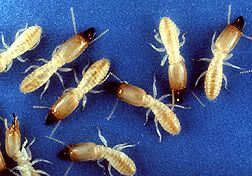
Here's an example of a Formosan subterranean termite soldier. The Formosans are much more damaging than the native subterranean termites. Note the difference in the heads between this and the native.
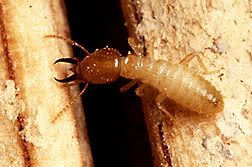
Here's a photo of the what swarming Formosan termites look like. These winged termites are also called termite alates.
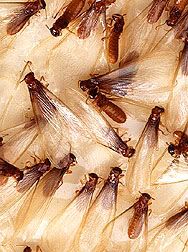
And here's a look at a queen termite. This is a picture of a Formosan subterranean termite queen. The queen can lay 1000's of eggs per day.
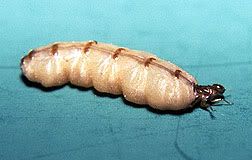
Saturday, May 28, 2005
Dry Wood Termites, Subterranean Termites, or Formosan Termites?
In terms of damage, Formosan termites are the worst. This aNola.com article has a story on ongoing research into the Formosan terimite. Formosan termites are native of the Far East. They've made their way into the US from coastal cities in the last 50 years. They've recently been very bad in New Orleans where major damage is being done in the historic French Quarter.
Early this month, scientists were warning that swarms of Formosan termites could be in the Baton Rouge area soon (from 2theadvocate news). Places in the south like Louisiana are particularly vulnerable to Formosan swarms due to the warm and moist environment. And June is the usual time when they start swarming.
Here are some disturbing facts about Formosans: they have very large colonies, can cause catastrophic damage in only a few months, the damage that they do can be difficult to detect until it's too late, and they can't easily be controled by soil poisons since they can survive without going into moist soil.
Back on the subject of termite identification, Formosan termites tend to be larger than US native termites like dry wood or subterraneans. The Formosans can live underground or just inside wood. Unlike the other ones, they can live in both conditions. Formosans are tan in color like dry wood termites. One important difference is that Formosans swarm later in the spring and only at night where as the dry wood ones swarm during the day.
Most of the subterranean termites live underground. Just a small percentage of them are workers who do the damage. Subterranean termite has a cigar-like black body with wings. And like the dry wood termites they tend to swarm during the day.
Here's a termite photo showing what Formosa termites look like:

Here's a termite picture showing what drywood termites look like:

And here's another picture of termite (subterranean kind):

Tags: termites
Thursday, April 07, 2005
Warmer Temperatures Brings Out the Termites
The expert interviewed by this article estimated that "as much as 60 percent of the homes in North Carolina have or will see termite activity in their lifetime."
One of the common termite symptoms is the discolored, soft or decaying baseboards.
The expert described the typical home treatment that he uses: "digging trenches inside and outside a house's foundation all the way around the home and filling them with insecticide."
Wednesday, January 12, 2005
Termite Season
The article mentions some good tips such as not signing a contract with pest control companies until you have compared at least 3 companies. In Florida, pest control companies are required by law to obtain a signed contract before treating a home. Also, be sure to check that the pest control company is licensed. For preventing termites, one useful tip it gave was to direct water out sources such as air conditioning drip lines or roof rain gutters away from the foundations.
In Florida, the two main types of termites are subterranean termites that attack structures from the ground and dry wood termites that can live in wood structures such as attics.
Sunday, September 19, 2004
Are Termites in Your House?

The above site (as listed on Google) has some useful info on determining if termites have took up residence in your home. The first sign is often the appearance of winged termites. The next signs are earthen shelter tubes which the termites use to as a passageway into the home from the soil. The third sign is hollow wood which is more likely to be found near the ground.
Sunday, September 12, 2004
More Ants vs Termite References
I've found a lot of useful resources for comparing termites vs ants. These all point to Google's image directory which caches picture thumbnails. First, its useful to understand how the different termites castes and how their looks change. Here's a good diagram of the termite life cycle:
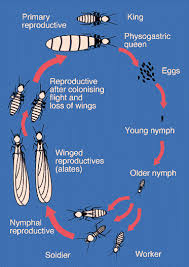
Here are some good comparisons between ants and termites. In addition to a good ant vs. termite diagram, it also does a good job at showing the differences between the various kinds of termites (soldiers, workers, winged reproductives, kings, and queens).

The following picture has a good comparison between winged ants and termites. The site which is on Google also has some good pictures of damaged that termites cause.
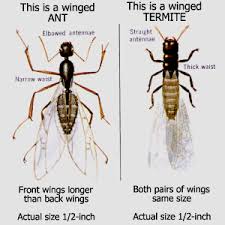
Friday, September 10, 2004
Beware of Treated Wood
To prevent damage by termites and to prevent rot, wood needs to be treated. However, beware of wood that has been treated with copper chromated arsentate (CCA). Lumber companies in the US have pledged to phase out the use of CCA in pressure-treated wood. However, there is still a lot of CCA wood in decks, play grounds, and in other places.
The arsenic in CCA wood has been proven to leach out. Long-term exposure to arsenic through breathing or skin contact can cause cancer. Be sure that you and your kids always wash hands after touching wood. Also, make sure kids don't play below decks. Be sure not to store toys under decks. Finally, don't burn treated wood.
Sunday, September 05, 2004
Picture of Termite
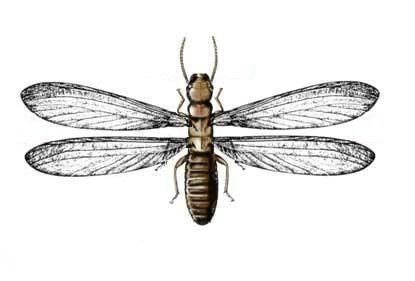
This picture of a termite shows some of the features that make it different than an ant. First, notice the antennae. The antennaes of termites tend to be bead-like. The antennaes also tend to be fairly straight where as ant antennaes tend to have elbow-like bents. Second, notice the wings. Unlike ants, termites have two pairs of wings that are similar in size and shape. These wings are usually as long or longer than the body. Third, note the body of the termite. It's a soft-body that is pretty much even. There are no bulges and skinny areas as there are in ants. Also, note the color. The color tends to be pale. Finally, it should be noted that many termites that you may see will not have wings. Younger termites will not have wings. Other classes of termites known as worker termites and soldier termites also will not have wings. In later posts, I'll include additional termite pictures.
Saturday, September 04, 2004
Ways to Eliminate Termites
I'll start by listing the basic ways of eliminating termites. In later posts, I'll go into each of these ways in much more detail. First, I'll start with the proven ways. These are the methods most professionals use. The last part of the list will include some less proven ways which can be cheaper and less toxic.
- Liquid pestisides are probably the most common. Like all pestisides, termiticides are toxic and should be applied safely. But one thing that makes termiticides application safer is that they are usually applied to the soil under and around the home so it has less chance to come into contact with people and pets.
- Termite baits are beginning to be used more and more. Instead of killing the termites like the pesticides, the baits are picked up as food by the worker termites and brounght back to the colony. This can provide a less toxic solution to getting rid of termites, however, it is usually more expensive and take a longer time.
- Nematodes is one organic alternative to chemical treatments. Nematodes are wormlike creatures which are deadly parasites to termites, but are harmless to people and pets. They can be bought online and delivered through the mail. One thing to point out is that their effectiveness is questionable.
- I've seen information regarding temperature methods to get rid of termites (also ants and roaches). One method would heat the house to above 120 degrees farenheit by blowing hot air into the rooms (after all flammable items have been removed). Another method does the opposite and chills the house with liquid nitrogen to -20 degrees farenheit (after pipes have been drained) These temperatures make the condition inside the walls unsurvivable for the insects. I have just seen a little on these techniques and I'm not sure how cost-effective they are.
Ways to Prevent Termites
As the old saying goes, an ounce of prevention is worth a pound of cure. So in this post, I'll give some basic ways to prevent termites from getting inside your home:
- Store firewood, lumber and other wood products away from your house. Also, be sure to completely remove all old stumps that are near the house.
- Keep the basement and areas around your foundation dry. Make sure you have proper drainage. Also make sure you leave room between bushes and your house. Termites need moisture along with wood.
- Keep everything that's wooden well painted. Paint that's pealing and cracking provides a way into the wood for the termites. Be sure to coat all wood heavily with resins, stains and paints.
Friday, September 03, 2004
Termites, Ants, and All Other Bugs that Do Damage
In this blog, I'll include resources to help you identify the type of insect that you've found in your homme. From termite pictures to termite diagrams, I'll do my best to help you track down the source of the problem. In addition, I'll provide tips about what can help and the required steps that should be done.
Together, we can win the battle of the bugs and keep these nasty creatures away from our family and home.
